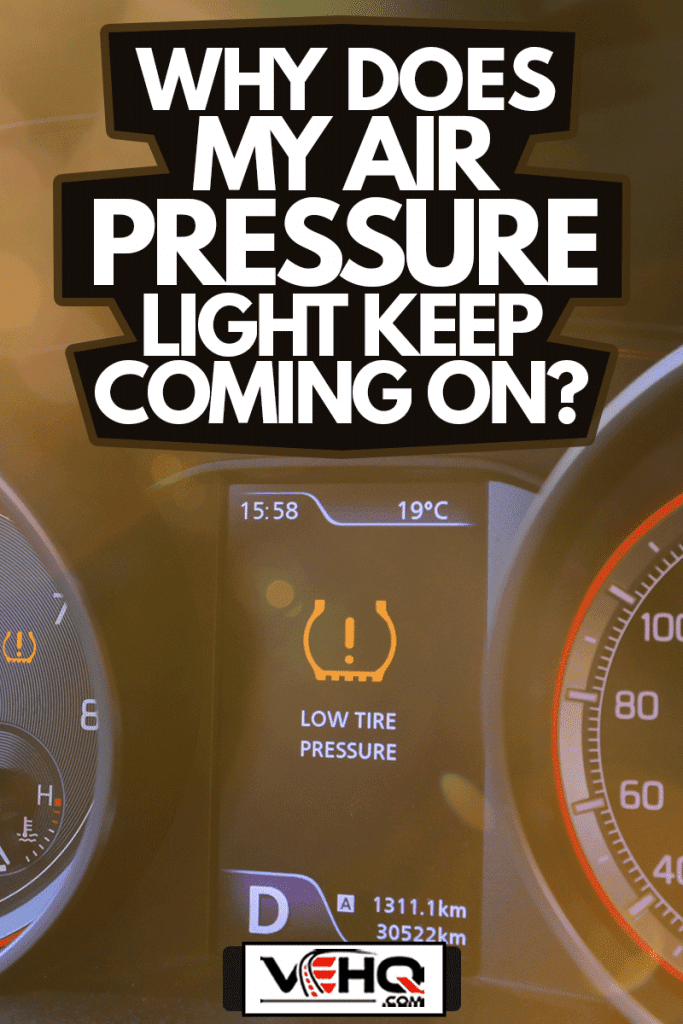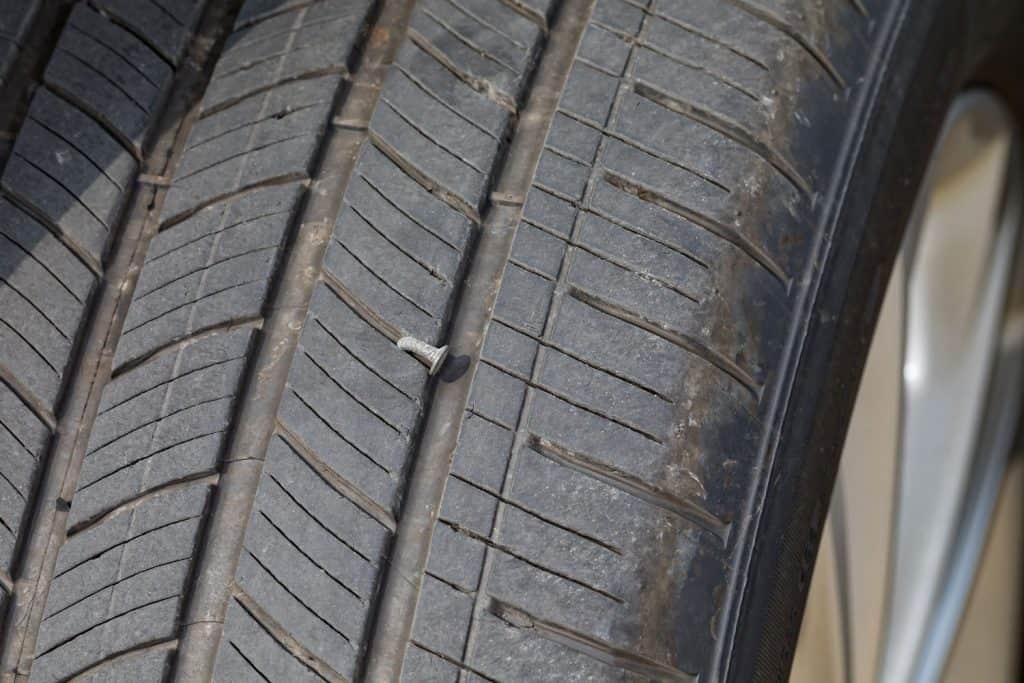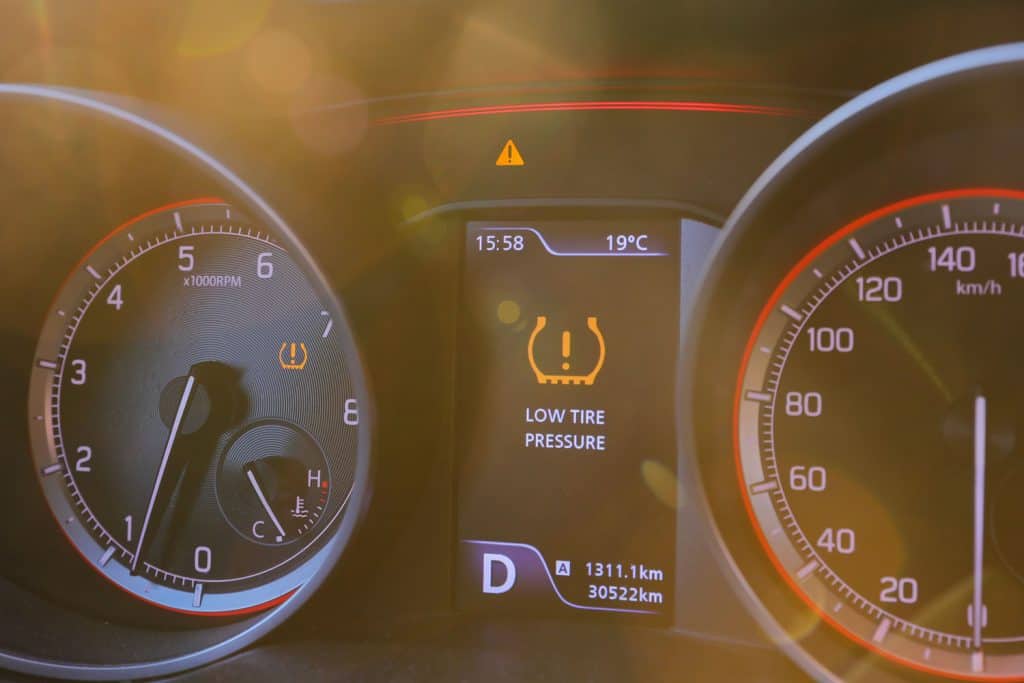Your tires are an essential part of getting to your destination safely. If your tire pressure is low, you may not get as much traction as you should while on the road. However, if your tire pressure is acceptable, why does your air pressure light keep coming on? We have researched for you to answer that question in this article!
Your tire pressure monitoring light may be coming on from outdoor temperature fluctuation. If the temperature drops while driving, so can your tire pressure. In addition, your tire pressure light may be coming on and staying on because of a bad tire sensor. Lastly, your tire light may keep coming on if you have something stuck in your tire, such as a nail.
It is usual for car tires to lose some air from time to time. However, if your tire pressure warning light is always on, it may be because of a faulty sensor, a puncture in the wheel, or a change in weather. In this article, we will take a closer look at these issues, so read on!

Why Does My Air Pressure Light Keep Coming On?
Your tire pressure monitoring system has a sensor designed to look at the air pressure inside your tires. This sensor is then sent back to the computer module so it can let you know when you have low or high air pressure in any one of your tires.
What is a TPMS?
A tire pressure monitoring system (TPMS) refers to a system installed on cars that monitors the pressure in the tires. If the tire pressure is too low, this alerts you by illuminating a red light on your dashboard and warning you to take action before an accident happens.
The TPMS sensors are located inside the wheels. When the air pressure drops, the sensor sends a signal to your car's computer, transmitting it to the dashboard.
That is why you should check if everything is OK with your tires whenever your TPMS light goes on. If there is low tire pressure, fill them up to avoid any problems.
The TPMS has a couple of components:
- A control unit located inside your car receives tire pressure readouts from each wheel's sensor.
- Wheel sensors located inside the wheels measure air pressure in real-time and send it to the control unit. If one or more sensors are improperly working, then this will cause your TPMS to display a red light.
However, there are times when you fill your tires to the appropriate tire pressure, but the tire light keeps coming on. Let's take a look at the reasons as to why this happens.
Temperature Fluctuation
Unfortunately, fluctuation in the temperature can affect your car's tire pressure levels. For example, if the outside temperature is cold and you are driving at a relatively high speed, you may notice that your tire pressure level goes down quickly. This may make it seem like your tire pressure warning light is always on when it could be because of the weather.
Puncture in Your Tire
The puncture in your tire is just one of the issues that can affect your car's tire pressure system. For example, when you have a nail, or some other object stuck inside it, this may trigger the tire pressure warning light to come on.
To prevent this from happening, make sure your tires are properly rotated and filled with air at the correct pressure. In addition, inspect your tires before you drive off to make sure nothing is stuck inside them.
Over time, repeated punctures may lead the system to believe that a tire is about to blow out, resulting in a flat or even a more severe accident. If you have had a nail lodged in your tire and then removed it, that may trigger the light to come on again. This is because your wheel sensor that reads the exact pressure in each tire might be damaged.
Bad Tire Sensor
Lastly, another reason why your air pressure light is always on can be due to a bad tire sensor. If this is the case, you will need to take your tire and wheel assemblies into a nearby auto parts store to test the computer module for a problem with a faulty sensor.
One of these three reasons listed above is likely the reason why your tire pressure warning light keeps coming on. For this reason, you will need to have your car checked out so they can diagnose the problem!
Is it OK to drive with the tire pressure light on?
It is not recommended to drive with the tire pressure light on. The reason for this is because your tires could be at a deficient air pressure level that may cause an accident if left unchanged.
This could be due to one of the culprits above, such as temperature fluctuations or a punctured tire. If your tire pressure light comes on, then get to an air hose as soon as your can.
However, if your tires are fine and you aren't losing air, but the light is still on, then more than likely, you have a faulty tire sensor. In this case, you are OK to drive with a tire pressure light on until you can get the sensor(s) fixed.
Now, if your tire pressure monitor or light is flashing, you have a flat tire, and you need to inflate the pressure in that particular tire back up to its required level. If your car's tire pressure monitor is flashing, it means that you should not drive on the tire with low air pressure because it can lead to a blowout.

How do I know if my tire pressure sensor is bad?
If your tire pressure monitoring system is not reading the correct tire pressure, it may be a bad sensor. These might indicate a faulty tire sensor:
- If your tire pressure is low, having checked with a manual tire pressure gauge, but the tire pressure light doesn't go off after filling the tire
- The pressure is stable
There are two ways to fix this issue. First, depending on how many sensors failed, the first thing you need to do is replace one sensor. If that doesn't correct the problem, then you will need to replace all four sensors.
How much does it cost to fix a TPMS sensor?
Typically, each tire pressure monitoring sensor replacement will cost between $50 and $100. However, if you have a faulty TPMS system like the tire pressure light is on, it won't go off after adding air to your tires, or one of the sensors has stopped working altogether, this may indicate that all four sensors need replacing.
Can I replace my own tire pressure sensor?
You can replace tire pressure sensors yourself, but it is best to leave it to the professionals. It will be tough to remove and install these sensors without damaging anything else near the sensor. In addition, if you damage any other parts when trying to replace sensors yourself, this can lead to additional expenses.
However, if you have a lot of mechanical experience with tires, you can replace your tire pressure sensors yourself. However, before you begin any auto repair on your vehicle, it is best to read up on how to change out a tire pressure sensor.
How long does it take to change a tire pressure sensor?
Typically, it can take about 30 minutes to an hour to change out a tire pressure sensor. However, if you damage any of the surrounding parts when removing and installing your sensors, this will take longer.
Can You Have a Tire Pressure Light Reset?
Yes, you can reset your tire pressure monitoring system. First, however, you will need to have the vehicle scanned with an OBDII reader. Once that is complete, you need to enter a code into your car's computer, and then it will reset the tire pressure monitoring system.
Final Thoughts

As you can see, there are different reasons why your tire pressure light keeps coming on. Some are more concerning than others. Nonetheless, if your tire pressure light keeps coming on then, you should have it checked by a tire shop. For example, there could be a nail stuck that you can't see, or the tire sensors are going bad!
If you like this article, then you should also check out:
How To Put Air In Tires Without A Gauge
